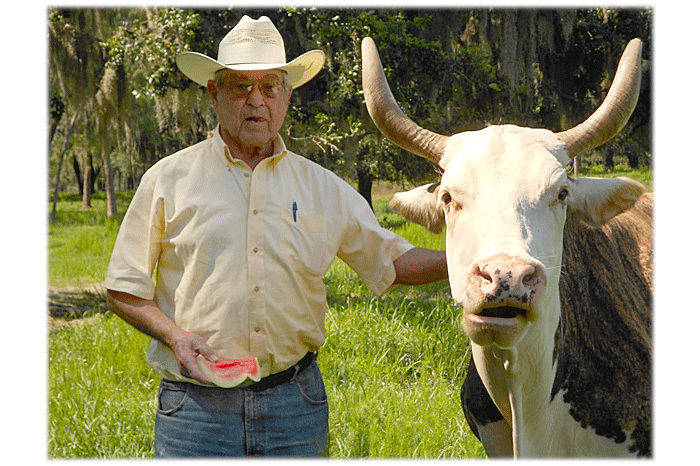| One rancher’s life pursuit to stay on top of Florida’s cattle commerce while meeting consumer demand |
Keeping up with the cattle commerce and pleasing consumers is an ongoing challenge for Florida’s rancher, thus making his paycheck defenseless. What breed brought the highest price the last two or three years may not be the favored commodity tomorrow.
Alvin C. Futch (also known as Mr. Alvin) is a Plant City rancher and published author of two novels, Wild and Wooley and Full of Fleas and Sawmill, depicting actualities and historical facts as they happened in the cattle industry. Futch explains, “I have owned cattle for 70 years and have been actively involved in the cattle industry in the good times and the not-so-good times.”
As a little boy, Futch received his knowledge and education about cattle from the saddle alongside his father, Ralph Futch. Senior Futch established his herd in the 1920s with Florida scrub cattle. He later purchased two Red Devon bulls, which was considered an elite breed during this time in Florida’s cattle trade. Futch says, “Dad wanted a cow that produced a better quality milk to be able to produce a better quality calf.”
“A few years later in the 1930s, Dad purchased two purebred Brahman bulls and this is when the cross breeding really began to show up in the herd,” continues Futch.
Gaining size to the cow took several years, but once this was accomplished senior Futch decided to cross breed, this time with an Angus bull. Although this would take some size from the calf, it would give additional confirmation, thus giving beef calves more profit value at the market.
The Horned Herford began phasing out the Angus in the 1950s. This up-and-coming breed would enhance the quality of the milk and give the Futch herd a three-way cross: Brahman, Angus, and Herford. Heifers with strong Brahman content bred with the horned Herford, was the chosen cow through the 1980s. A cow would produce a 1,000-pound brindle white-face calf, usually. With a smile Futch concedes, “You don’t get any better than that!”
Eventually buying his father and mother’s spread, Futch continued to implement hybrids through channels of cross breeding. This avenue gave upgrade to his herd and at the same time allowed him to keep using the knowledge that was passed down to him from his father.
In 2000 Futch made the decision to go with Brangus bulls for breeding. “The Brangus have proven to be the best all around,” Futch states.
Carol Perocchi, wife of the late cattleman George Perocchi and long-time friend and neighbor to Futch, shared how being a rancher was his destiny. “As kids going to Midway School together and working with my husband, Alvin had no real choice but to become the cattleman he
is today.”
At present, you will find the Brinks bloodline, a bloodline from southern Texas, in Futch’s herd. This is a bloodline known for its growth, confirmation, and producing good market value.
Remembering what his father taught him about cross breeding being necessary to keep up with the market and to keep your herd strong and profitable, in 2011 Futch went back to a Herford cross producing black baldy calves. This is a continuation of the hybrid vigor and will sell as well as the purebred Angus or the Brangus.
Futch says, “There is no telling how long things will last as they are today. But one thing for sure, if you are in the cattle business to stay, it is best to bring in new breeds to keep the hybrids’ vigor alive.”
This message, along with true stories of what happened in his youth as a young cowboy, is what Alvin C. Futch gives reference too in his autobiographies. By linking the past with the present, he is retelling history as it really happened. He tells of the homespun battles the Florida cowboy went through to help make Florida the industrious state that it is. He depicts a very unique breed of an American hero: the Florida cowboy. This hero chooses a bedroll over a bed, a horse over a car or truck, and oftentimes a tree stump to eat his meal from instead of a table.
CREDIT
story and photo DALE BLISS

